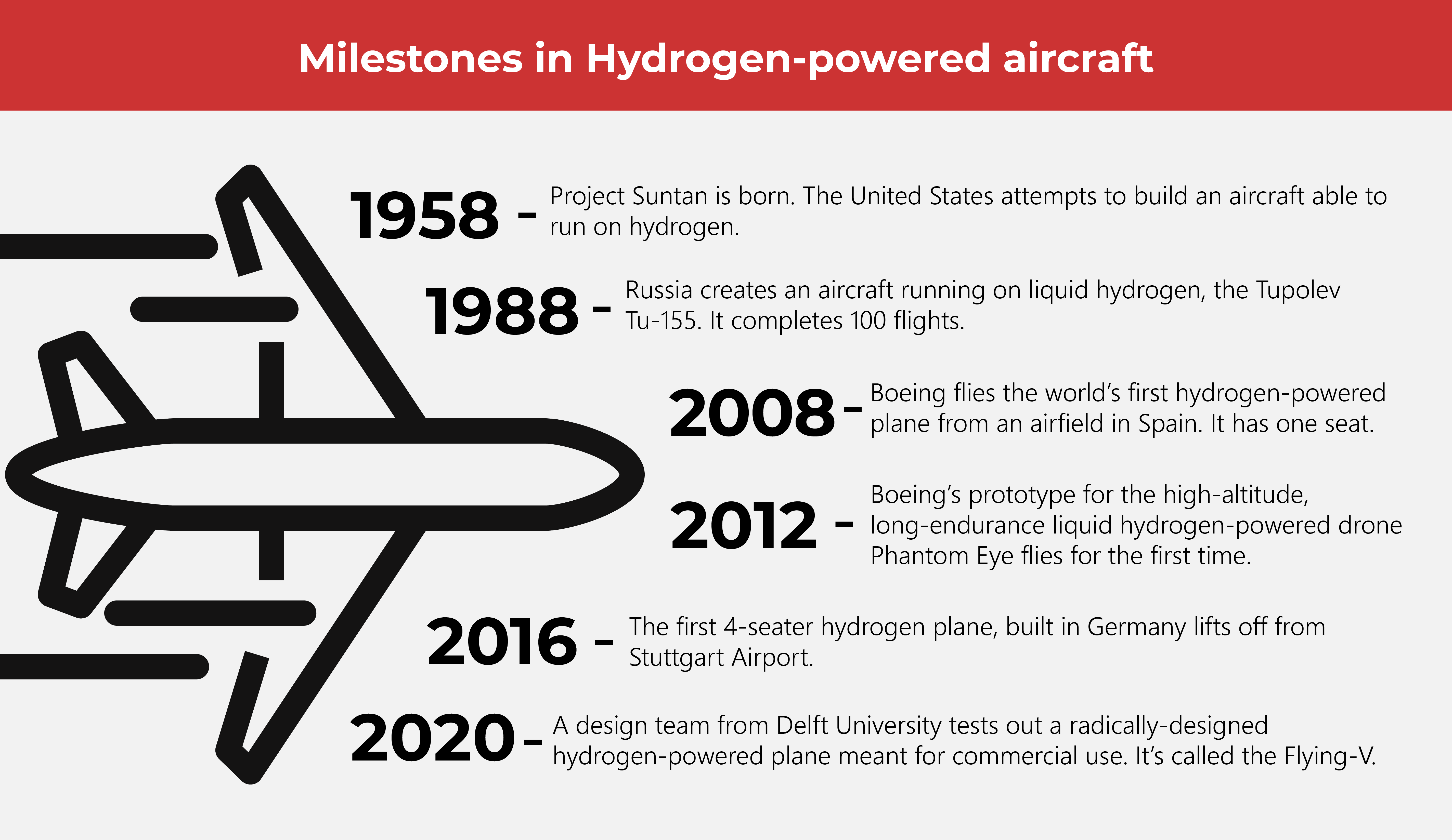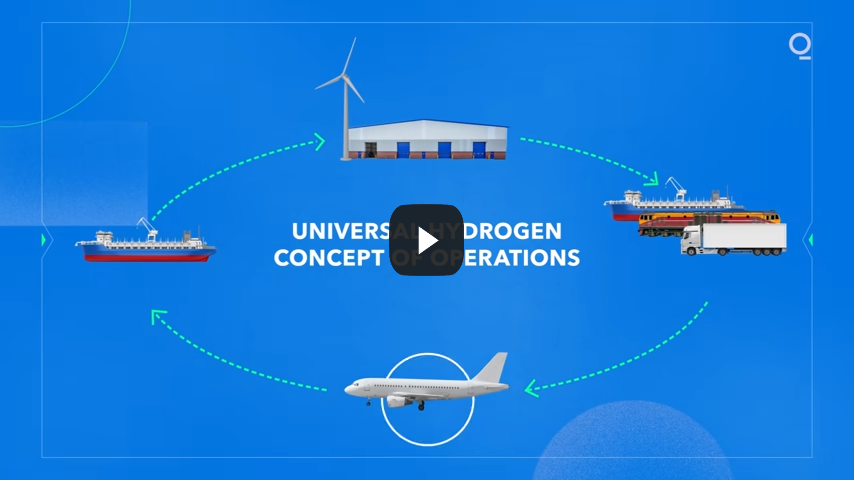All Aboard the Hydrogen Plane

The European Commission says that the aviation industry contributes 3.6% of EU greenhouse gas emissions, and 2.4% of global greenhouse emissions. By the global calculus, the aviation industry is lagging when it comes to zero-carbon mobility. Can hydrogen-powered commercial planes be the solution the industry is looking for?
From Cold War to Climate War
This might come as a fascinating surprise to some, but the concept of hydrogen-powered airplanes has been around since the 1950s, at the onset of the Russia-U.S. cold war. American spies thought the Soviets were building a hydrogen-powered aircraft, and in response, the highly top-secret Project Suntan was born. Engineers led by the genius designer from Lockheed, Kelly Johnson attempted to build an aircraft that could fly not on kerosene, but hydrogen.
Problems the early engineering team encountered then became challenges that are still being resolved today. The problem with hydrogen-powered aircraft was related to the range of travel of the plane and the volatility of liquid hydrogen. However, the “hydrogen race” gave birth to one of the most tantalizing and enduring aviation challenges still being studied and developed in today’s world: how far can hydrogen-powered planes take us?
Today, the technology behind hydrogen-powered airplanes is continuously being tested within aviation spaces, but the reasons have less to do with competing nations and more with the global issue of reducing carbon emissions to prevent global warming and climate change from worsening.
Airplanes use kerosene, which is a hydrocarbon fuel. When an airplane’s fuel is burned, its by-product is carbon. Scientists have long been attempting to find solutions to increase aircraft carbon efficiency, and for the most part, there have been advancements made in the last sixty years. However, with climate change rapidly becoming a bigger problem every day, time is running out.
The aviation industry faces several challenges at once: how do those in the industry reduce carbon emissions, and increase fuel-burning efficiency while also addressing transport, safety, and profitability demands?
Could the answer be in hydrogen-powered airplanes?
Liquid hydrogen: burning cleaner and greener
Hydrogen is plentiful. It’s the most abundant element on Earth, in its natural gaseous form. Liquid hydrogen, on the other hand, is man-made. From its early days in top secret government projects, scientists know that it is possible to have vehicles run on liquid hydrogen. Unlike kerosene, when liquid hydrogen burns, its by-product is simply water vapor, not carbon, which makes liquid hydrogen a strong alternative for fueling airplanes.
Most hydrogen-powered vehicles run by using hydrogen to power a fuel cell, combust an engine, or a combination of both.

Innovations take time to develop, test, and perfect. The challenge for the aviation industry is built on so many moving parts: changing/worsening climate conditions and tradeoffs that can’t help but be made when redesigning is involved. And with hydrogen in the equation, redesigns need to be made.
Hydrogen is denser than kerosene, and storage is tricky. There currently is no stable infrastructure or ecosystem that supports the storage, transport., and safe refueling of the aircraft. What’s more, because hydrogen has several different qualities from kerosene, it cannot be stored in the aircraft the same way as kerosene is. The use of hydrogen to fuel airplanes entails the redesign of airplanes as we know them.
Redesigning brings engineers back to the drawing board, and that lends plenty of opportunity for a lot of trial and error. Tweak one element of the aircraft, and everything else has to be re-calculated, re-calibrated, and essentially, re-imagined. Thanks to technology, computer design, and simulation tools help speed along the redesigning.
(Also read: Robotics Help Aviation Reach New Heights)
A few things hinder the innovation and developments being made from fully being introduced on a commercial level. One major issue is teamwork and politics. Scientists and engineers note that innovations will be faster if teams were able to share knowledge. Unfortunately, much like the cold war of the 1950s, the competition between giant aviation corporations is fierce.
Another factor is safety. The IATA explains what studies show: certain characteristics of hydrogen make it safer as fuel than kerosene, while other characteristics make hydrogen more dangerous. For example, hydrogen has a lower flammability limit than kerosene, but kerosene leakage is easier to avoid and easier to detect than hydrogen.
The IATA reports that the U.S. Department of Energy has announced a $250,000 fund to power air vehicles with hydrogen fuel cells. This shows solid commitment from the American government to support the aviation industry’s efforts to reduce greenhouse gasses. Their fact sheet goes on to say that around the world, there have been fifty policies signed by national governments in support of the development as well as implementation of hydrogen as a fuel for aircraft. These countries include nations such as the United Kingdom, China, India, Japan, Korea, New Zealand, and Saudi Arabia.
Hydrogen holds the potential to help uplift the aviation industry, and in turn, contribute more towards decarbonization. The European Commission projects that by 2050, 40% of aircraft in the EU region will be powered by hydrogen. As ambitious as that may sound, with other countries agreeing to support the initiative, hydrogen-powered commercial planes might be landing on airport runways soon.
As one of the Top 19 EMS companies in the world, IMI has over 40 years of experience in providing electronics manufacturing and technology solutions.
We are ready to support your business on a global scale.
Our proven technical expertise, worldwide reach, and vast experience in high-growth and emerging markets make us the ideal global manufacturing solutions partner.
Let's work together to build our future today.
Other Blog




